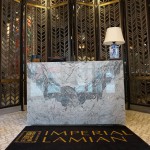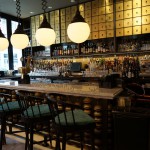By Ya Zhou
Chicagoans can dine on authentic and modern Chinese cuisine at Imperial Lamian‘s first U.S. location in the heart of Chicago’s bustling River North neighborhood.
The restaurant takes its name from lamian, a traditional Chinese food with a history dating back to the 16th Century. The process of making lamian involves taking a lump of dough and repeatedly stretching it to produce many strands of thin, long noodles. La means “to pull,” and mian means “noodles.”
“I tell my staff members that we are here not to serve the guest–we are here to educate the guest and show them what Chinese cuisine is all about,” said Imperial Lamian’s CEO Vincent Lawrence.
The new Chicago restaurant is the first American location of a family-owned business based in Indonesia for over a decade. Imperial Lamian has over 30 restaurants specializing in modern Chinese cuisine, including Xiao Long Bao, which are soup dumplings, and Wok dishes, cooked in the traditional Chinese wok.
Imperial Lamian in Chicago is currently open only for dinner. After studying and working in the United States , Lawrence and his partner started rebranding and launched the Chicago project two years ago.
“Here, we are the only restaurant that features the actual pulling of noodles,” said Lawrence. “We make the noodles fresh by hand. The texture is very authentic, so it holds the flavor of the broth really well.”
Imperial Lamian’s Chicago location has three executive chefs: Chef Wang Hongjun focuses on fresh, hand-pulled lamian noodles, Chef Lim Kee Tiong specializes in dim sum and xiao long bao, and Chef Kok Lam Andy Foo oversees both traditional and new, inventive wok dishes.
“Chicago has a big void in authentic Chinese food, especially in a restaurant with a modern environment and high-level service. Imperial Lamian fills that void, offering really authentic Chinese food outside of Chinatown,” said Lawrence.
As guests enter Imperial Lamian, they see an elaborate foyer with hand-made Oriental screens and birdcage pendant lights—a nod to the story of the Chinese bringing their birds with them when dining out.
Right next to the screen, the bar area features a backdrop of rustic brass Chinese medicine boxes and a 15-foot bright, colorful mural.
All the dishes are made fresh to order in the open kitchen–including the hand-stretched noodles.
The restaurant seats 150 and features two private dining areas, including a private dining room for 30 and a semi-private space that fits 40.
“People have a certain mindset when it comes to Chinese food, but our service, food, ambiance and music really set us apart from other competitors,” said Lawrence. “We want to provide a great dining experience, serving authentic dishes in a modern, hip space.”






